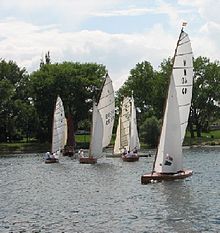10 m² racing dinghy
The 10 m² racing dinghy , also known as the N-dinghy , is a free construction class whose building regulations only specify the projected sail area of no more than 10.70 square meters and a few material thicknesses for the hull. The dinghy may with a crew of max. two people can be sailed.
It is originally derived from the class of sailing gigs . Sailing gigs were divided into different categories based on the sail area. A sailing gig with a sail area of 10 m² had the IV symbol. The IV later became the N as the sailing symbol for the 10 m² racing class, which has been preserved to this day.
The first constructions came from Germany and Austria around 1910. However, the 25th Ordinary German Sailing Day of the DSVb, which met on November 27, 1921 in the Kaiserhof in Berlin, can be described as the hour of birth of the 10 m² racing class Decision to classify the 10 m² gigs in class IV from now on as 10 m² racing dinghy class.
In the period around 1925 there was an underlined "D" for the 10 m² racing dinghy in Berlin at the German Sailing Association for the so-called 10 m² federal racing dinghy and an underlined "C" in the sail for the independent sailing associations.
The heyday was in the 1930s. This is how the unit ten designed by Reinhard Drewitz was created in 1932 , which has three rings lined up as a sailing symbol, arranged in a similar way to the Olympic symbol. The construction of the unit ten was precisely specified ( unit class ) so that exactly the same boats could sail against each other in regattas. From then on, in addition to the free tens, in which every ten could sail, there were also their own unit tens regattas.
Due to the events of World War II and in the post-war period, many 10 m² racing dinghies were lost or destroyed. In the 1950s and 1960s there were still some new buildings made of plywood and plastic. At the end of the 1970s, this class of boats quickly disappeared from the lakes. Today there are around 30 copies in Germany and Austria. In Japan, on Lake Biwa near Kyoto, there has also been a unit ten since 1939.
The class has been reorganized since 2010 and has sailed an international class championship on the Wallersee in Salzburg , with only one free tens.




